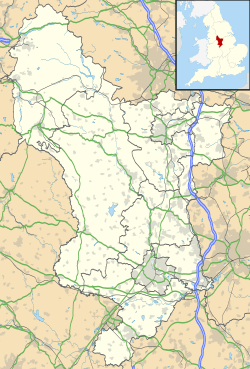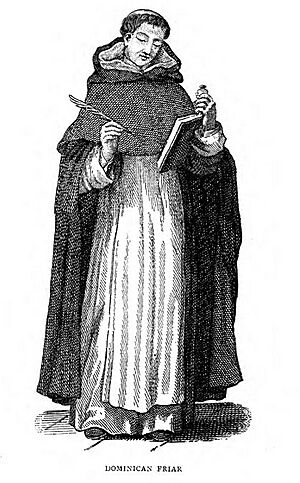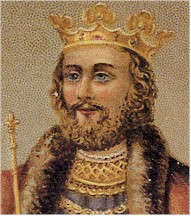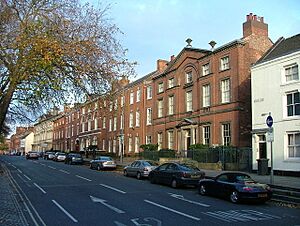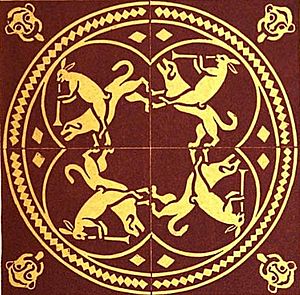Derby Blackfriars facts for kids
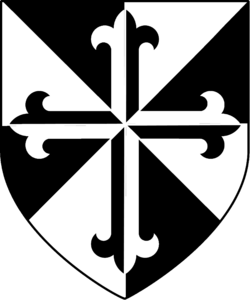
Coat of Arms of the Dominican Order
|
|
| Monastery information | |
|---|---|
| Other names | Derby Dominican Friary Blackfriars, Derby |
| Order | Dominican Order |
| Established | 1224-1238 |
| Disestablished | 1539 |
| Dedicated to | The Annunciation of Our Lady |
| Diocese | Diocese of Lichfield |
| Site | |
| Location | Friar Gate, Derby, England |
| Coordinates | 52°55′24″N 1°29′02″W / 52.9232°N 1.48383°W |
| Grid reference | SK 3480 3632 |
| Visible remains | Remains of the cellar thought to have been incorporated into the house known as "The Friary", and stonework from the priory used in foundations. A single medieval wall remains at the rear of this building. |
The Derby Black Friary was a special kind of monastery called a Dominican priory. It was located in Derby, England. People also called it the Derby Dominican Priory or Blackfriars, Derby. The name "Black" came from the black robes the friars wore.
This friary was founded in the 1200s. It was supported by kings and queens until it closed in 1539. The priory was built just outside Derby's old town walls. Today, a building called "The Friary" stands on its site. This building used to be a hotel and is now a nightclub.
The Derby Black Friary was one of three religious communities nearby. Not far away was King's Mead Priory, home to Benedictine nuns. Also close by was St. James Priory, Derby, where Cluniac monks lived.
Contents
History of the Black Friary
How the Friary Started
The Derby Black Friary was started between 1224 and 1238. This was during the time Alexander de Stavenby was the Bishop of Coventry and Lichfield.
It was built on the west side of Derby, just outside the town walls. The friary was dedicated to "The Annunciation of Our Lady".
The friars who lived here were called "The Friar Preachers of Derby". This is because members of the Dominican Order believed in going out to preach to people. They did not stay hidden away like some other religious groups. Dominican houses were not allowed to own large amounts of land. They only owned the land their priories were built on. This meant the Derby friary did not get huge land gifts like other monasteries. However, people did donate money to make the friary's land bigger. It grew to over 16 acres.
The 1200s at the Friary
King Henry III was very generous to the friary. In 1229, he gave them 20 marks to help build their church. He gave more money in 1242 and 1244 for construction.
In 1291, the friary received £5 from the will of Queen Eleanor. She was the wife of King Henry III and a big supporter of the Dominicans.
It is believed the church was built slowly, piece by piece. When King Edward I visited Tideswell in 1277, he gave money specifically to help build the church there.
The Story of Frate Ruffolo
An unusual event happened at the friary in 1257. An old book about the Dominican Order tells the story. A young friar named "Frate Ruffolo" became very sick while in Nottingham. He was cared for by the Franciscan friars there.
After receiving holy blessings, he closed his eyes and smiled. He said he was happy because King St. Edmund had entered his room. He also claimed the room was full of angels and that the Virgin Mary had come. Then, he said he saw Jesus Christ coming to judge him.
Frate Ruffolo then screamed in pain. He began to sweat and shake all over. He started speaking as if answering questions about his life. "It is true....O my Jesus, pardon that offence, for it was slight," he said. The friars with him asked, "Are we judged for such small offences?" He replied, "We must suffer the punishment for all."
His judgment seemed to go well. Frate Ruffolo then said, "Assuredly, He (Jesus) is merciful, and I have tasted of His mercy." With those words, he passed away.
The 1300s at the Friary
The Dominican Order held important meetings called "provincial chapters" at the friary. In 1310, King Edward II gave £10 to pay for two days of food for the meeting. More meetings were held in 1346 and 1376. For these, King Edward III gave £15 and £20.
King Edward II visited the Derby area in 1323. He stayed in Nottingham and then at a royal hunting lodge. During this time, he visited Derby and the friary. He ordered money to be paid for the friary's costs in hosting him. The next year, he visited Derby again. He gave money to feed the friars for a day. This payment suggests there were about 26 friars living there.
In 1344, the friary was attacked. A large group of men broke in. They cut down trees and stole goods worth about £60. Many friars and servants were hurt. The leader of the friary got a legal order naming 44 people who were thought to be involved. These included local chaplains and tradesmen. It seems the issue was settled outside of court.
The friary's barns were used to store royal wool. In 1354, a man named John de Bredon was in charge of about 80 stone of wool at the friary. He was sent to prison because he let most of the wool rot. He then sold what was left for his own profit.
In 1374, John of Gaunt, 1st Duke of Lancaster, gave the friary timber from three oak trees.
The 1400s at the Friary
In July 1403, King Henry IV stayed two nights in Derby. He was traveling between Nottingham and Burton upon Trent. He gave money to the friary to make up for any damage caused by his royal group.
The 1500s and the Friary's End
Around 1534-1535, the friary faced a big threat. This was the time of the dissolution in England. This meant many monasteries were being closed down by the king. Because of this, many English Dominican Friars left for other countries. The Derby friary usually had about 30 friars. But with the threat of closure, the number dropped to only 6.
On January 3, 1539, the friary was officially given over to the King. At that time, it had an income of £18 16s 2d after paying its costs. The old seal of the friary was attached to the surrender document. This seal showed the Annunciation, with the Virgin Mary and the Archangel Gabriel. Below them, the Prior was shown praying.
What Happened After the Friary Closed?
The friary and its land were immediately rented out to a man named John Sharpe. The next year, he got a longer lease. But there was a rule: all the building materials from the extra buildings (which were to be torn down) and all the trees belonged to the King.
In 1544, John Sharpe took another man to court. He claimed the man had broken into the former friary. He said the man stole marble gravestones, lead, iron, glass, and timber. These items were valued at £4.
What Remains Today?
The friary was located on a street now called Friargate. This area became very built up as Derby grew. Friargate has many old buildings from the 1600s. In the 1700s, it became a popular place for rich people to live. Many large Georgian houses were built, like what is now the Pickford's House Museum. The street also had schools, a prison, and later a railway station.
The exact spot of the friary is now taken by a building called "The Friary." This building was built around 1730 for Samuel Crompton. When it was built, another old building, thought to be part of the original friary, was still behind it. Stones from the original friary were even used in the foundations of the new house. These remaining friary buildings were torn down in the early 1800s.
"The Friary" house was changed and made bigger over the years. In 1922, it was sold and turned into the Friary Hotel. Later, in 1996, it became a pub. Today, it is a nightclub.
Behind the house, there is still a very old wall. Many people believe this wall was part of the original friary. The cellars of the house also have parts of a medieval building. These are thought to be from the friary, but it's not 100% certain.
Found Artifacts
Human bones and old floor tiles have been found near "The Friary" house. These are believed to come from the friary's old burial ground.
Ghost Stories
Some people believe the area where the friary once stood is haunted.
The building known as "The Friary" has had many reports of ghosts. People say they have seen monks dressed in black. This makes sense, as Dominican Friars wore black robes. There have even been sightings of a headless monk! "The Friary" is a stop on local ghost tours. The ghosts of monks are most often reported in the cellars. These cellars are thought to be part of the original friary buildings.


